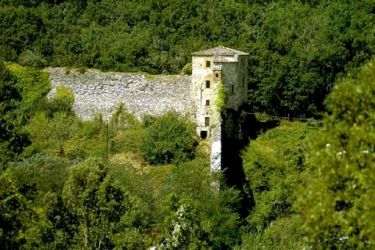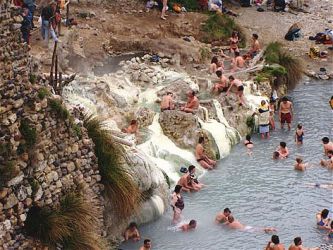Petriolo
The remains of the fort of Petriolo are located at the northernmost part of the territory of Civitella Paganico, at the border of the municipality of Monticano. Petriolo was well-known because of the curative properties attributed to its sulphurous hot springs. Petriolo was known to the Etruscans and Romans, and it is also mentioned in a document of 1130. Its reputation spread not only within the immediate area but also across Italy and even abroad, and Petriolo was visited by many well-known people. The most famous visit, in particular with regard to the history of the Republic of Siena, was that of Pope Pius II Piccolomini who made a number of visits in the hopes of curing the gout from which he suffered. Indeed, a number of important Papal Bulls were issued from this region. Petriolo was praised by the writer and poet Folgore da San Gimignano.
The Siennese Republic had a number of single cabins built in 1250 that were rented to bathers. They also carried out research in order to open new thermal springs and farm buildings in 1330, as well as establishing a vicarship. Ten years later they initiated a tax on the bathers.
In the 17 C the area began to decline in favour of the baths at Pignoni and San Filippo. However the Ospedale di Santa Maria della Scala in Siena revived the springs which came under the authority of the Grand Duke of Tuscany, who passed it on to the Cospi family in 1648. In 1713 the Ospedale obtained permission to demolish the castle walls and to make use of its stonework. Today all that remains of the walls are those connected to the tower. Only one of the four original baths remains.
Petriolo is still very popular with locals who soak in the hot mineral water where it cascades down the bank via a number of artificial pools into the Farma river.
The Siennese Republic had a number of single cabins built in 1250 that were rented to bathers. They also carried out research in order to open new thermal springs and farm buildings in 1330, as well as establishing a vicarship. Ten years later they initiated a tax on the bathers.
In the 17 C the area began to decline in favour of the baths at Pignoni and San Filippo. However the Ospedale di Santa Maria della Scala in Siena revived the springs which came under the authority of the Grand Duke of Tuscany, who passed it on to the Cospi family in 1648. In 1713 the Ospedale obtained permission to demolish the castle walls and to make use of its stonework. Today all that remains of the walls are those connected to the tower. Only one of the four original baths remains.
Petriolo is still very popular with locals who soak in the hot mineral water where it cascades down the bank via a number of artificial pools into the Farma river.


